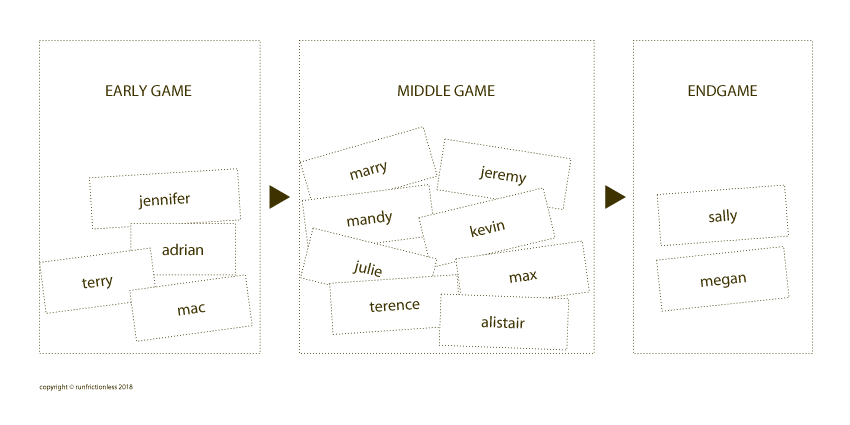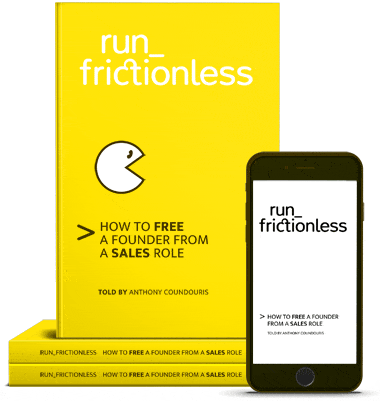
A frictionless customer experience in five steps
>
👌 frictionless customer experience with five best practices
If you only had time to learn 🎓 five practices to improve customer experience, what would they be? Here are our top 🙌 five practices to create a frictionless customer experience.
Stop bad habits costing your customers. Instead, cultivate an appetite for eliminating friction. Whether you are from an internet startup or a consulting firm, you will find these five practices indispensable.

1. BRAND EVERY EXPERIENCE
We yearn predictability. So having consistency in the way that we brand each customer interaction is important. Consistent branding builds cues that you are a predictable organization. Therefore, the product they’re buying is going to be of quality.
For example, imagine the packaging and experience leading up to the buying decision is superior. Before seeing the price tag, the customer prepares themselves for a high price tag.
If you want to charge a premium or avoid being discounted by the customer, improve brand consistency.
This is particularly important when you don’t offer a free trial of the product. Offering a free trial lifts the barrier and places less emphasis on the packaging because the product can be trialed before purchase.
The practice of consistent branding is more than applying the logo to every piece of collateral. It is the corporate identity which is important.
A corporate identity is a sum of both the logo and the visual language. The visual language includes fonts, colors, imagery. When a customer does not see the logo, they still can identify the brand by the visual language.
A visual language reinforces brand recall. It is the reason we recognize a Duracell battery or a Ducati motorcycle before we see the logo.
The brand guideline and editorial style guide are a means of achieving consistent application of the corporate identity. A brand guideline guides how pictures are used. An editorial style helps guide the use of words.
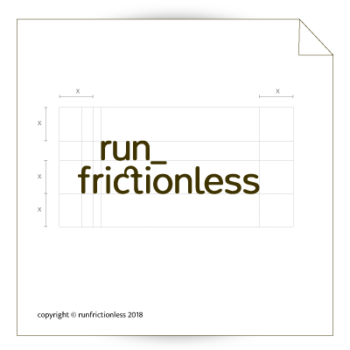
2. MANAGE FEWER INTERACTIONS
The fewer interactions you manage, the less friction. Each business requires a minimum number of customer interactions in order to create a customer. If you serve small businesses, this could be 15 interactions. If you serve enterprise, the number could be 25 or more interactions.
In other words, at every customer interaction, there is a risk the customer will experience friction and drop-off. Overall, the fewer customer interactions in your sales system, the less potential for friction.
Many founders often start a business serving enterprise customers and later substitute this customer profile for small businesses. They are attracted by the high ticket price their product can fetch if they serve enterprise until they calculate the cost of serving.
Every interaction must serve a purpose and help create a frictionless customer experience. So, eliminate interactions that do not serve a purpose and bloat the flow.
3. CREATE LOW TOUCH EXPERIENCES
A low touch customer flow is typified by interactions that require little or no human input from the business.
The advantage of a low touch system is that not only does it make the buying decision faster for the customer, but it means the business can handle more sales volume, without adding more salesforce. Low touch interactions are easier to measure, script and automate.
With each customer requiring less time from the salesforce, the cost of acquiring a customer falls and profit rises.
Startups typically begin with high touch interactions, and over time as the flow is improved, introduce low touch activities. Until you get to product-market fit, company activities are inefficient because you are trying to figure out how to make a customer.
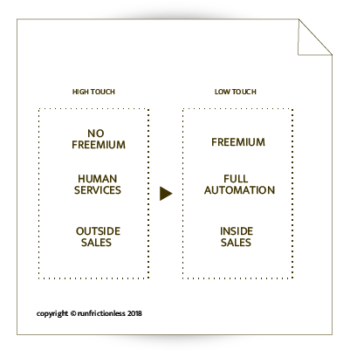
You risk losing touch with your customer if you become low touch. By keeping the pulse of the customer, you are able to collect intel and make improvements.
4. CREATE FAST EXPERIENCES
If you cannot design an original experience which ‘wows’ customers, just be fast.
Response time is an easy dimension to win a customer. Businesses can win customers simply because they serve the customer’s first, not because they have a better product. This explains why companies with inferior products make sales over companies with superior products. They win based on speed.
By the time a competitor has written their first email reply, your business has established the company’s credentials, and booked a demo for tomorrow.
Serving customers expediently doesn’t mean herding or begging the customer to make buying decisions. Rather you want the customer to feel like they are in control, even though they are in fact experiencing a well-tuned, lubricated machine, designed to produce a frictionless experience.
In the U.K. during 2016, we conducted a sales friction test on visa immigration service providers. A request for visa services was sent to 30 licensed immigration providers. Here were the results:
These kinds of sloppy customer experiences allow new competitors to enter. If you are a startup about to make a move into this space, rub your hands together because you are about to make revenue.
5. REMOVE EXPERIENCES WHICH BLOCK CUSTOMERS
Website gimmicks like pop-ups that demand a visitor’s email address don’t create frictionless customer experience. Instead, they turn customers away. Blocking a customer from achieving their goal infuriates them. So often we demand a customer give us a bunch of particulars before we agree to serve them.
Consider a customer – let’s call her Sally – walks into the supermarket.
Sally: Can you tell me which aisle I can find kitchenware?
Sales assistant (blank-faced, slowly replies): Before I can speak to you I need your name and email address.
Sally: I just want to know where kitchenware is! Surely I don’t have to give you my life history?
Sales assistant: Sorry. I need your name and email before I can speak to you.
Sally: But you are speaking to me. Sales assistant: That’s beside the point. I need your name and email.
At some point during the dialogue, it may become necessary to take the customer’s name and email address to facilitate answering their inquiry. Raise it only if it is required – don’t add friction.
An example that comes to mind is check-in kiosks at airports. Airlines have recently introduced these devices to improve efficiency. The kiosk demands you input a passport and flight number. What the kiosk design is blind to is the fact that customers are often holding bags and don’t have the fingers to touch type.
Unless you consciously decide never to serve a particular customer profile, never block customers. Businesses delight in devising schemes which serve their own goals, and not the customers.

Advanced
practices
worth
mentioning
The next few practices taken from the book run frictionless made our shortlist, but not our top five. These practices are difficult to master.
However, if you decide to learn the next few practices, you are on your way to creating a uber frictionless customer experience. First, though, we need you to understand how the early, middle, and endgame work.
Are you ready?

Broadly, every customer interaction can be grouped in either the early, middle or endgame. The early, middle and endgame is a cute and memorable way of understanding the customer’s buying decision. The three stages can be referred to as awareness, evaluation and, purchase.
We use this classification to help the salesforce understand where a customer is snagged and what action to take to nudge the customer forward. Placing customers into stages helps the salesforce understand what to do next.
Pheeeew! Back to the article.
6. CREATE THREE ‘WOW’ CUSTOMER EXPERIENCES
Wow moments or key interactions are turning points in the customer journey. They are the interactions that have the greatest impact on customer experience. Key interactions occur when significant value is delivered to a customer, or an important decision is made that will triage the customer into a more appropriate customer flow.
You only get two or three opportunities to wow your customers. This is partly because of budget restrictions and partly because some interactions are by nature passive or transactional.
If you serve small businesses, you could be managing 15 interactions. That means only 20 percent of these interactions will blow the door off the hinges.
Experiments we conducted proved that when we nailed these key interactions, 90 percent certain of customers left a positive review. However, nailing key interactions is not as easy as it seems. Which is why this practice appears in the latter half of the article.
To master these three interactions will require you and your team to spend hours talking about each of the three, collectively studying customer feedback and examining how you could go deeper, splitting each interaction into smaller parts.
There are no rules when wow moments take place, but in my experience, a key interaction normally marks the beginning of the middle and endgame.
7. UNDERSTAND CUSTOMER EXPIRY
Earlier we named creating fast experiences, one of five practices to frictionless customer experience. It turns out there is a sinister, more insidious threat than a competitor who beats you to the punch. It is called customer expiry.
Time is an important dimension to making a buying decision. Every customer goal has an expiry. If the goal is not achieved in the time frame, the customer is highly likely to drop-off and abandon their buying decision.
During the course of writing the book run frictionless, we discovered expiry could be as short as 11 minutes if a customer was deciding where to dine tonight or around six months if the buying decision involved procuring a large platform for their enterprise company.
The next time your salespeople complain the competitor has a better product, remind them of customer expiry. The aim is to help the customer achieve their goal in the shortest possible time.
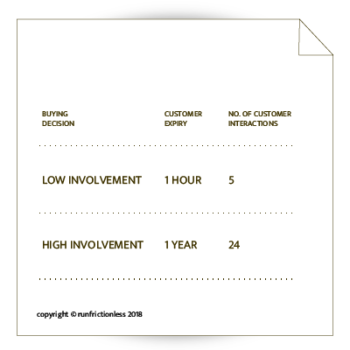
8. FOCUS ON A SINGLE CHANNEL
Have you experienced a sales agent trying to move you from an online chat to a telephone call? Or from a telephone call to an email? You are mid-conversation and the agent wants to change the channel. It disrupts the experience.
In 2018 we conducted a sales friction test on clinician practices in Sydney Australia. To test if clinics would block a customer, the customer attempted to book a consultation over email. Each of the four clinicians contacted refused to take a booking. Instead, they insisteted the customer telephone the clinic and made an appointment over the phone.
Sally: I’d like to book an appointment to see the clinician either tomorrow or Friday.
Agent: I’m sorry, we cannot take your booking. Call this number now.
If you are a startup medical practice in this sector, offer your customer an online booking engine instead of email or telephone, and watch your competitors crumble.
9. BUILD CREDIBILITY IN THE EARLY GAME
In the early game, you have a lot to get done in a short time frame. An important part of the early game is ensuring every prospect is educated about why they should do business with your business – not why your product is good but why your organization is different.
By the time the customer arrives at the end game, trying to make a buying decision is tough. All the products look the same.This is because competitors compete on features. So the customer’s image of your company could decide the outcome.
Establishing an awareness of what makes your company different from the beginning, will make it easier to close customers later.
10. NAME PRODUCT LIMITS IN THE EARLY GAME
The customer learns as much about the product through limits as they do reading a list of functions. Every product, no matter how perfect, has limits. Limits are experienced in a restaurant business, a consulting firm, and internet startups.
Manufacturers know that naming limits improves customer experience. For example, a television is shipped with a warning label that reads: do not operate in water. Naming this limit achieves two outcomes. It ensures the customer has a positive experience. Secondly, the customer learns this is not a product to be used outdoor.
It is important to name limits in the early game. Otherwise, you risk adding friction in the endgame. A common phrase we hear from customers who were sold a product and not told limits:
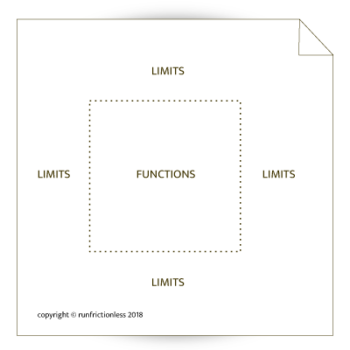
Remember: a customer learns as much from the list of functions as they do from the list of limits. The boundaries of expectations are defined by both functions and limits. During the course of writing the book run frictionless, we discovered one way to deal with limits, is to offer work-arounds.
Work-arounds are a temporary measure designed to overcome friction until a better solution can be found. Even technology giants like Google with above USD 1BN market cap solve product limits with work-arounds.
11. RECOGNIZE YOU CANNOT SERVE ANYONE
Who do we serve, is a question every startup or business owner needs to get their head around.
A common phrase I hear technical founders tell me is “anyone can buy the product”. While that is true, it is not anyone you are trying to convince to buy. You’re trying to convince one person, Sally, to buy, and Sally won’t buy if Sally is not convinced the product is right for her.
While there may be some parallel between the two, the number of interactions will be different and varied. The two may share interactions from the early game. However, the experiences and the words and pictures required to convince each group to buy will be different in middle and endgame.
Be careful you are not serving too many customer profiles. Each interaction you support costs money. You may run short of cash and cannibalize one customer profile to serve another.
12. GATHER INTEL AND MAKE IMPROVEMENTS
This situation plays out in organizations every day. Salespeople hold the intel in their heads, and based on the knowledge, create their own sales collateral. Soon sales and marketing are diverging, creating vastly different words and pictures to communicate to customers. The two departments are going in different directions, all because intel was not gathered and shared.
The second reason gathering intel falls down is because the intel is gathered, but the intel it not acted upon.
The way I combat both situations is by setting up a board using one of many ticketing applications available on the cloud. Salespeople can pop the intel on a board in a few seconds from their mobile devices. That makes it easy to collect, and they can store the intel during a customer interaction, not later when they go back to their desktop PC and forget.
Intel is so important to improving the customer experience. Every day your business interacts with customers, and learns nothing from these interactions.
Intel appears on the board as a ticket. At the end of each week, each ticket can be sorted and reviewed. Some tickets can be put on hold until more intel is gathered before action is taken. Other tickets can be combined together to create a bigger, richer story. Whilst a few tickets may be ready for action now.
Action can include a small change like the form capture fields on a website, to more strategic changes like a new feature in the product or a new pricing structure.

get started
using the
4Qs
Key takeaways

run frictionless
now for only US$995



